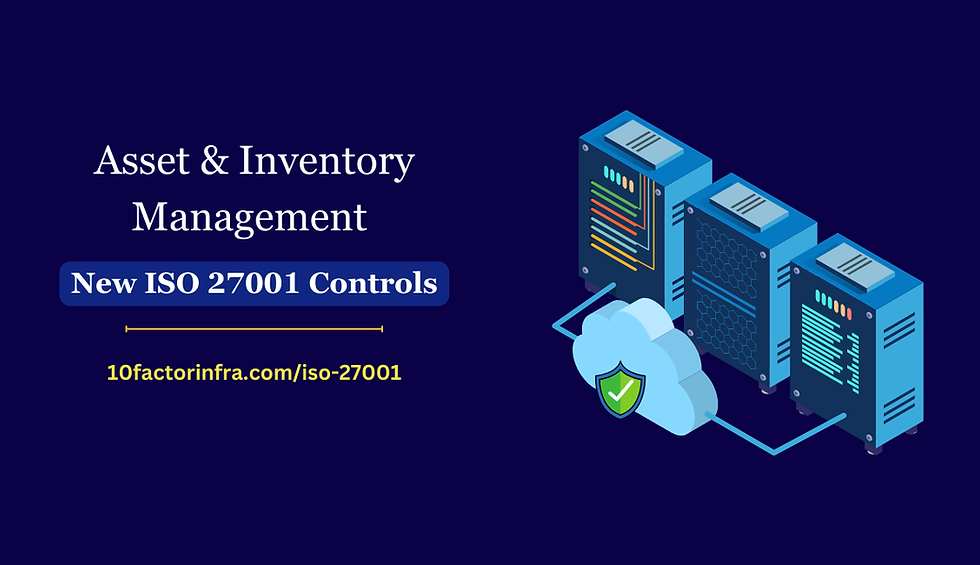VPNs For ISO 27001 Compliant User Endpoint Devices
- Kamalika Majumder | DevOps & ISO 27001 Consultant

- Aug 1
- 4 min read

As remote work, cloud-native applications, and BYOD (Bring Your Own Device) policies become the norm, securing user endpoint devices is no longer optional - it’s foundational. Endpoint devices such as laptops and mobile phones are entry points to an organisation’s digital assets, and attackers often target these as weak links in the security perimeter.
To meet the growing demands of security and compliance, especially under ISO/IEC 27001:2022, organisations must adopt automated, scalable, and policy-driven mechanisms to manage endpoint access.
The ISO/IEC 27001:2022 update recognises this evolving risk surface by introducing Control A.8.1 – User Endpoint Devices, which mandates organisations to protect information stored on, processed by, or accessible through endpoint devices.
To meet this requirement effectively and at scale, modern enterprises are turning to Compliance-as-Code (CaC)—a methodology that codifies compliance policies into machine-readable definitions, enabling automated deployment, validation, and remediation across user devices.
This article outlines how automation can secure user endpoint devices while achieving alignment with ISO 27001:2022 through key strategies like VPN onboarding portals, IAM and SAML integration, RBAC-driven network segmentation, and TLS-encrypted access.
Understanding ISO 27001:2022 Control A.8.1 - User Endpoint Devices
This control focuses on minimising the risk of data leakage, unauthorised access, and malware infections originating from endpoints.
Control A.8.1 – User Endpoint Devices states: "Measures should be implemented to protect information stored on, processed by or accessible via user endpoint devices."
Key objectives include:
Defining secure configurations
Managing access rights
Applying encryption and anti-malware protection
Monitoring endpoint health
Enabling remote wipe or device lock in case of loss or theft
The control emphasises proactive configuration and monitoring, not just reactive response.
Compliance-as-Code applies software development principles—like version control, testing, and automation—to compliance implementation. For endpoint security, this means:
Codifying endpoint configurations (e.g., password policy, disk encryption)
Automating deployment via device management tools
Using scripts or declarative policies for continuous validation
Automatically remediating non-compliance
Instead of checking compliance after incidents occur, Compliance-as-Code allows organisations to embed security and compliance into endpoint lifecycle management.
VPNs For ISO 27001: 2022 Control A.8.1
ISO 27001 requires Information stored on, processed by or accessible via user end point devices shall be protected.
Compliance-as-Code can help organisations implement and enforce A.8.1 across thousands of endpoints.
This module deploys a client vpn solution that provides secure access to your applications, systems and services hosted within a private network.
This provides two vpn options - AWS Client VPN & Openvpn Access for organisations to choose from either cloud managed or self-managed solutions. Here’s what you get:
🚀 Client VPN with Self-Service Onboarding Portal
Automated onboarding portals reduce friction for users and eliminate manual configuration errors. New users can be granted secure VPN access through a self-service interface tied to HR or identity workflows. This aligns with Control A.8.23, which mandates securing data transfer.
Integrate natively with IAM Identity Providers and auto-provision users based on identity federation.
Codify user group access and routing for cloud or on-premise environments where full control is needed.
🧑💼 IAM & SAML Authentication for User Managed & Secure Access
Centralised authentication using IAM systems and SAML integration ensures consistent identity enforcement across all endpoint access, aligning with Control A.6.1 – Identity Management. MFA, session policies, and conditional access can be uniformly enforced.
Supports direct SAML 2.0 federation with identity providers like Okta, Azure AD, or Google Workspace. It also integrates with IAM Identity Center for seamless access policies.
Supports LDAP/RADIUS natively for on-premise setups.
🧩 Automated RBAC for Network Access Control
Role-Based Access Control (RBAC) restricts users to only the network resources required for their role, fulfilling Control A.5.15 – Access Control. Automation ensures RBAC policies are consistently enforced and updated during user lifecycle events (e.g., role change or offboarding).
Well defined access based on IAM roles and routing tables. For example, developers may access only staging subnets, while finance teams connect to billing systems—enforced through codified policies.
Codified group-based configuration, access routing rules for server profiles.
🌐 Public DNS and Signed Certificates for Trusted Access
Using public DNS endpoints with TLS certificates ensures encrypted and authenticated communication from endpoint devices, satisfying Control A.8.24 – Use of Cryptography.
Integrates with AWS Certificate Manager (ACM) to automatically issue and rotate certificates.
Combined with Route 53, DNS routing is secure and automated.
🔒 Encrypted and Whitelisted Network Access
Endpoints should only access approved network resources through encrypted channels—aligned with Control A.8.21 – Security of Network Services. Whitelisting and segmentation reduce exposure.
Lets you define per-user route tables, subnet access, and security groups. These policies are declarative and version-controlled.
Achieve segmentation using push routes and iptables, with careful configuration and active monitoring.
Conclusion:
ISO/IEC 27001:2022 makes it clear—endpoint security is no longer optional. Control A.8.1 mandates measurable protection of user devices, not ad hoc controls or occasional patching.
Between Cloud Managed and Self-Managed Solutions, the right choice depends on your infrastructure:
Choose Cloud Managed for seamless integration, managed infrastructure, and codified security.
Choose Self-Managed when full control, on-prem hosting, or vendor independence is a requirement.
Either way, the goal remains the same: secure endpoint access, minimal attack surface, and continuous compliance.
And the Compliance-as-Code package makes this process seamless by ensuring:
✅ Scalability: Easily roll out secure configurations to hundreds or thousands of devices
✅ Consistency: Avoid human error by standardising policy enforcement across operating systems
✅ Audit-ability: Maintain versioned records of all compliance policies and changes
✅ Speed: Detect and remediate non-compliance within minutes, not days
✅ Security: Prevent unauthorised access and data loss by continuously enforcing safeguards
Save time with automated evidence collection, and focus on confirming that your controls work properly.
Need to get ISO 27001 or SOC2 Compliant, but not sure where to start!
Thanks & Regards
Kamalika Majumder






